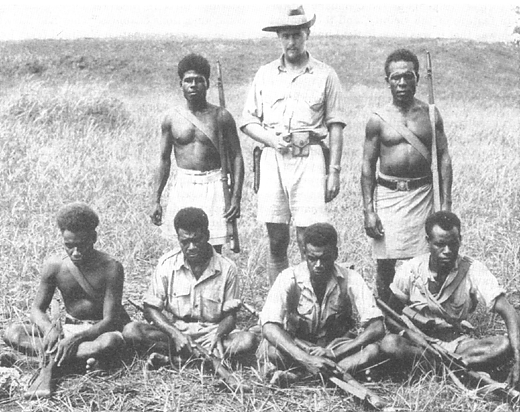- Biuku Gasa and Eroni Kumana
Biuku Gasa and Eroni Kumana were
Solomon Islands natives ofMelanesian descent who discoveredJohn F. Kennedy and the rest of "PT-109's" crew following the boat's collision with the Japanese destroyer "Amagiri" near Plum Pudding Island onAugust 2 ,1943 .During
World War II , Biuku Gasa and Eroni Kumana were tasked with patrolling the waters of theSolomon Sea nearGizo with Australian coastwatcher Lt.Arthur Reginald Evans . OnAugust 2 , both were ordered by Evans to search with their dugout canoes for possible "PT-109" survivors. Kennedy and his men survived on coconuts for six days before they were found by the two islanders. Unfortunately, the canoes couldn't accommodate all of the PT-109 crewmen safely; and perhaps more importantly, the islanders had a hard time communicating with the English-speaking crew. In absence of writing utensils, Gasa suggested that Kennedy should inscribe a message on the husk of a coconut plucked from a nearby tree. This message was then delivered by rowing 35 miles to the nearest allied base, and a successful American rescue operation ensued. [ American Warriors:Five Presidents in the Pacific Theater of World War II, Burd Street Press, ISBN 1-57249-260-0, 2003 ] [http://www.americanwarriorsfivepresidents.com]Kennedy later invited Gasa to attend his presidential
inauguration , but the pair was duped en route in Honiara, the capital, by colonial officials who sent other Solomons' representatives. [ [http://www.time.com/time/pacific/magazine/article/0,13673,503050815-1091374,00.html From TIME pacific Magazine, issue dated August 15, 2005 / No. 32 Monday, Aug. 08, 2005 A Friend in Deed] ] Another version of the story is that they were turned back by officials at the airport. [" [http://news.nationalgeographic.com/news/2002/11/1120_021120_kennedy_pt_109_2.html The Islanders who saved Kennedy] " - National Geographic] As far as is known, no one has since offered them a visit to the president or the United States.
250px|thumb|right|Lt._Arthur Reginald Evans , Gasa and Kumana would have looked similar to this photo of Captain Martin Clemens, Australian Coastwatcher on Guadalcanal, rendered services to Allied forces during the battle for the island. The natives were members of the Solomon Islands police force.]Recognition
Another scout, Alesasa Bisili, wrote of his experience during the 1942 Japanese landing at Munda in "Scouting in Western Solomons". He expressed sadness and anger over the unjust lack of recognition and award given to Solomon Islanders for their services during the war.
However, Biuku Gasa lived in a house paid for by the Kennedy family ($5k), National Geographic ($5k) and the balance ($15k) by Brian and Sue Mitchell, in recognition of his help. [ [http://news.bbc.co.uk/1/hi/world/asia-pacific/3107103.stm BBC news 30 July, 2003] ] The reference that the Kennedy family paid for the entire house in the BBC is incorrect. The house was designed by Brian Mitchell in co-operation with a Brisbane-based Australian architect. Melody Miller (Senator Edward Kennedy's Press Secretary) was responsible for pulling all the parties together after being approached by Brian and Sue Mitchell. The Kennedys also constructed a house for Kumana. It fell down in the 2007 tsunami, but Kumana survived the storm. [ [http://www.swimforgizo.oceanswims.com/] ]
In 2003, a swim was organized to raise money for Gasa's community.
Biuku has since passed away on 23 November 2005
Life
Gasa was born July 27, 1923 in Madou, Solomon Islands. He went to a missionary school, but did not speak English well. He would have been 20 when he met the young skipper. Biuku Gasa lived in Vavudu Village, Kauvi Is. [ [http://www.pt109swim.com/The%20Results.htm] PT-109 swim results] After the war Gasa and his wife Nelma had six children. They lived off coconuts and crops. They also caught fish in
Vonavona lagoon . Gasa is the local patriarch as most of the residents are descendants of the "old man" as he is known, and he rarely left the island. Most roads are unpaved, and most of the huts do not have electricity even today. Gasa was still alive in August 2005 when the Pacific edition of Time magazine wrote that he was sick in the hospital. His children built a canoe just like the old man had made, to send to the United States "so they would not forget". It is not known where this canoe is today.Fact|October, 2007|date=October 2007Eroni Kumana, said he was 78 in 2003, and would have been 18 in 1943. He also was schooled by missionaries. He still lives in Konqu Village, Ranongga Island. He is seen in National Geographic photographs with a hat and a T-shirt that said "I saved JFK". Kumana created a shrine with an obelisk to JFK, and appointed him honorary chief.Fact|October, 2007|date=October 2007
Gasa and Kumana were interviewed by National Geographic in 2002, and can be seen on the DVD of the television special. They were presented a bust by Max Kennedy, son of Robert Kennedy. The National Geographic had come there as part of an expedition by the Titanic Wreck hunter Robert Ballard, who did find the wreck of the PT-109.Fact|October, 2007|date=October 2007
Notes
External links
* [http://news.nationalgeographic.com/news/2002/11/1120_021120_kennedy_pt_109.html] National Geographic News "JFK's Island Rescuers Honored at Emotional Reunion" Ted Chamberlain November 20, 2002
* [http://www.questia.com/PM.qst?a=o&se=gglsc&d=5000254533&er=deny Taem Blong Faet: World War Two in Melanesia Journal article by Franz Broswimmer; Oceania, Vol. 64, 1993] "Alesasa Bisili's narrative 'Scouting in Western Solomons', describes his experiences as a scout during the Japanese landing at Munda in 1942. Like Zoleveke, he too expresses sadness and anger over the unjust lack of recognition and award given to Solomon Islanders for their services during the war... The contributions are by Biku Gasa, Aron Kumana, (the two Solomon Islanders principally responsible for Kennedy's rescue), John Kari and Andrew Langabaea"
* [http://blog.oregonlive.com/oregonatwar/2007/09/eroni_kumana_gets_his_flag.html "Eroni Kumana Gets His Flag"] Associated Press report, September 2, 2007
Wikimedia Foundation. 2010.

